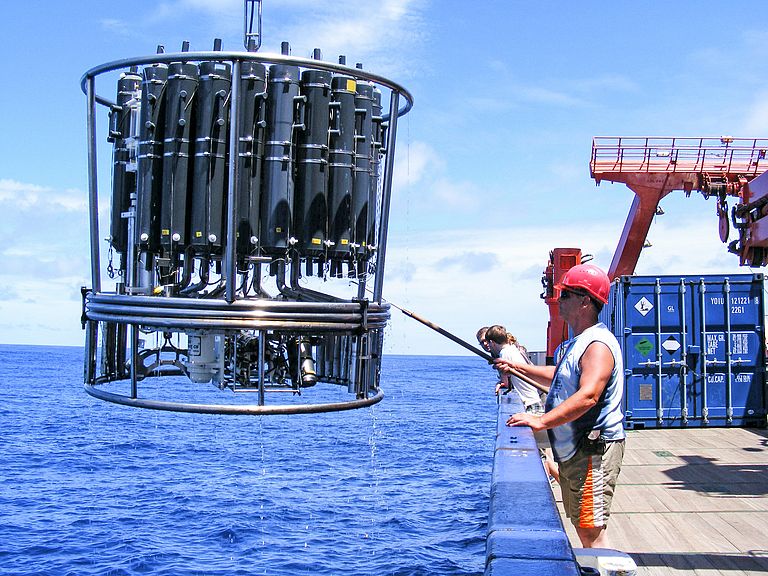Oxygen depletion in the ocean is increasing
Science study reveals risks, but also suggests solutions
Abound a year ago, oceanographers from Kiel, Germany published a study that illustrated that the ocean has lost two percent of its global oxygen in the past 50 years. Now an international team of scientists has once again investigated the evolution of oxygen in the oceans. The new survey, published today in the international journal Science, looks for the first time at causes and consequences, as well as possible solutions for the deficiency of oxygen worldwide, both in the open sea and in coastal waters.
“Our data shows that in the past half-century, the area in the open ocean, in which all oxygen is lacking, has grown more than fourfold”, says Prof. Dr. Andreas Oschlies from GEOMAR Helmholtz Centre for Ocean Research Kiel, one of the authors of the new study. In coastal waters, including estuaries and marginal seas, low-oxygen sites have increased more than tenfold since 1950. “We also expect oxygen levels to continue to fall outside these areas as the Earth continues to warm”, explains Professor Oschlies.
“Oxygen is fundamental to life in the oceans”, says Denise Breitburg, lead author and marine ecologist at the Smithsonian Environmental Research Center in Washington, USA. "The drop of oxygen in the ocean is therefore one of the most serious effects of human activity on the Earth's environment”.
The study is a result of international cooperation in the Global Ocean Oxygen Network (GO2NE). This is a working group set up in 2016 by the United Nations Intergovernmental Oceanographic Commission (IOC). For their study, the participating authors evaluated about a quarter of a million data sets and also carried out calculations for oxygen concentrations in oceans with the GEOMAR climate model.
For the subtropical and tropical Atlantic and the corresponding latitudes in the Pacific, many data originate from expeditions and observational campaigns of the Collaborative Research Centre 754 "Climate and Biogeochemical Interactions in the Tropical Ocean". For almost ten years, this Kiel network has intensively studied the naturally occurring oxygen minimum zones in the eastern parts of the two large oceans. “We were also able to detect an expansion and intensification of oxygen depletion and thus a restriction of the habitat for fish, crabs and mussels," reports Oschlies, who is the spokesman of SFB 754. And the climate models operated at GEOMAR predict an accelerating spread of the oxygen-depleted zones in the event of further global warming.
For the scientists global warming is the major cause of increasing oxygen depletion. Warmer surface water contains less oxygen. It also makes the stratification of the ocean more stable, which reduces mixing and circulation processes and makes it harder to ventilate the interior of the ocean. Another factor is the euthrophication of the oceans, especially near the coasts. This leads to algae blooms, which consume a lot of oxygen after the death of the algae.
Of course, the increasing oxygen depletion of the ocean also has an impact on the livelihoods of people, especially in developing countries. Smaller artisanal fisheries may not be able to move if oxygen depletion destroys their fishing grounds or forces fish to seek out for new habitats. Also coral reefs, an important tourist attraction in many countries, could die without sufficient oxygen.
In order to limit the further expansion of oxygen depletion and to reduce its consequences, the participating researchers propose three actions. “Of course, it is very important to combat the causes, i.e. the nutrient load and climate change”, Professor Oschlies emphasizes. At the same time, protecting endangered regions or species could reduce the pressure on ecosystems. In order to be able to carry out these actions successfully, an improved monitoring of the oceanic oxygen content is also necessary, state the authors. “Unfortunately, we still have too few observations from the ecosystems in the open ocean. This has to be improved for effective protection”, emphasizes Andreas Oschlies.
Scientific Paper
Breitburg, D. L. A. Levin, A. Oschlies, M. Grégoire, F. P. Chavez, D. J. Conley, V. Garçon, D. Gilbert, D Gutiérrez, K. Isensee, G. S. Jacinto, K. E. Limburg, I. Montes, S.W.A. Naqvi, G. C. Pitcher, N. N. Rabalais, M. R. Roman, K. A. Rose, B. A. Seibel, M. Telszewski, M. Yasuhara, J. Zhang (2018): Declining oxygen in the global ocean and coastal waters. Science, doi: 10.1126/science.aam7240
Note
The Collaborative Research Center 754 (SFB 754) "Climate and Biogeochemical Interactions in the Tropical Ocean" was established in January 2008 as a cooperation between Kiel University and the GEOMAR Helmholtz Centre for Ocean Research Kiel. The SFB 754 investigates the changes in ocean oxygen content, their potential impact on the oxygen minimum zones and the consequences on the global interaction of climate and biogeochemistry of the tropical ocean. The SFB 754 is funded by the German Research Foundation (DFG) and is in its third and final phase (2016-2019).
High-res images
Contact
Jan Steffen (GEOMAR, Communication and Media), Phone: +49 431 600-2811, presse(at)geomar.de




